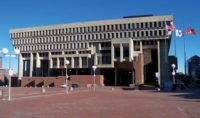When Boston City Hall opened in 1968, New York Times architecture critic Ada Louise Huxtable praised its plaza as “one of the best urban spaces of the 20th Century,” noting that it was inspired by the Piazza del Campo in Siena, Italy.
Huxtable was in the minority. Even architects who admired the Corbusian brutalism of City Hall—which, like the plaza, was designed by Kallmann McKinnell & Knowles—criticized the seven-acre treeless expanse as out of scale, windswept, and devoid of civic virtue. This has been pretty much the consensus for the past half century, but now Boston is finally doing something about it. On Tuesday, Mayor Martin J. Walsh unveiled a scheme by local firm Sasaki that will transform the plaza into a “welcoming front yard for civic life.”
In fact, this is one of the “four pillars” of the $70 million project. The others are: to make the space a flexible and accommodating event venue that is fully accessible; to conceive it as a model for sustainability and resilience; and finally, to foster a renewed cultural and architectural legacy that will respect the design of City Hall and even retain some original elements of the plaza.
For example, while dozens of trees will be planted, and the convoluted series of multiple levels and stairs will be flattened, much of the brickwork, in a fanned pattern with granite bands, will be preserved. The largely unused north entrance will be transformed into the Hanover Promenade, to provide a more direct link to adjacent Faneuil Hall and Quincy Market.
“I’ve been part of the rhetoric of this building and plaza for most of my life,” says Boston native Kate Tooke, an associate principal landscape architect at Sasaki, who is involved in the design. “We need a place where we can come for celebration and protest.” The plaza is where the entire sports-mad city gathers for team championships, and anti-busing protests took place there in the 1970s. The new central Main Plaza will accommodate 12,000 people, while the new plaza overall will hold up to 25,000, down from the present 40,000 maximum, yet the design is democratic, with no evident discouragement of large gatherings.
Other features: a “Speaker’s Corner” for the mayor to make important announcements; a play area for children; and a new civic building on Congress Street to host and support events.
Phase I of the plaza project is now in design development and is expected to open at the end of 2021. At the same time, as reported by RECORD in January, City Hall itself is undergoing a reimagining and renovation, with some parts completed and more is to come.
Overall, there seems to be a grudging admiration for the existing plaza, though falling far short of Huxtable’s praise.
“The plaza’s renovation will honor its original intentions and history,” says Isabel Zempel, a Sasaki principal, “while making it a more accessible place for all.”










Post a comment to this article
Report Abusive Comment